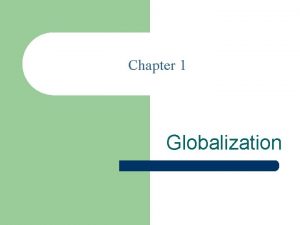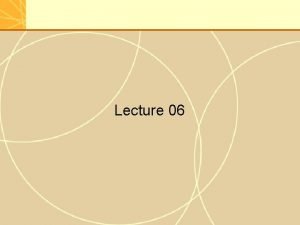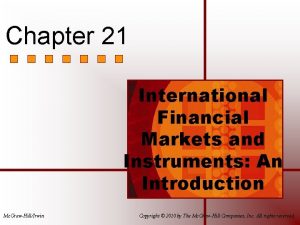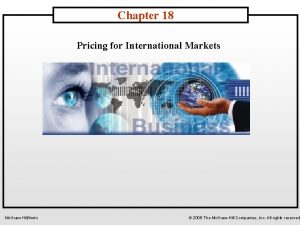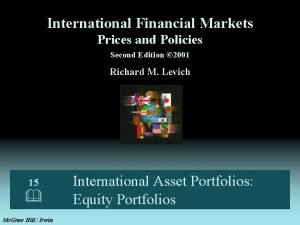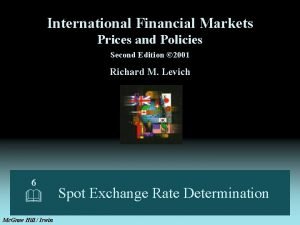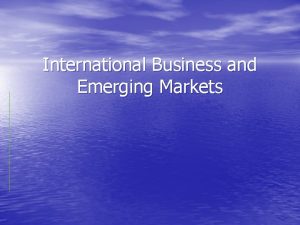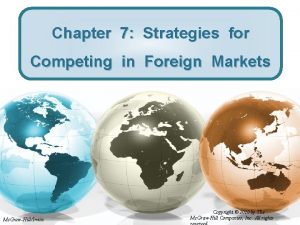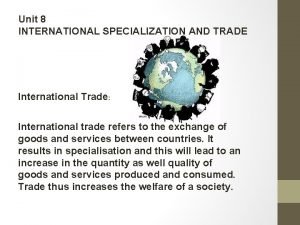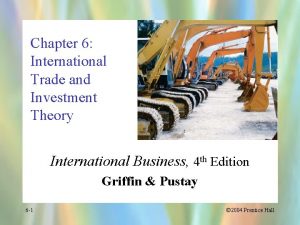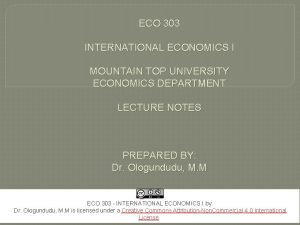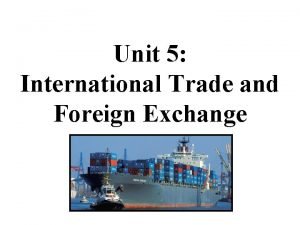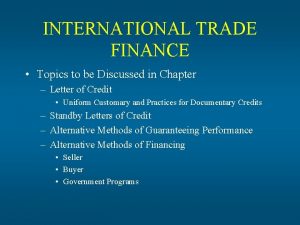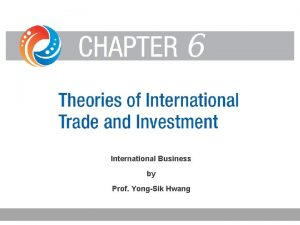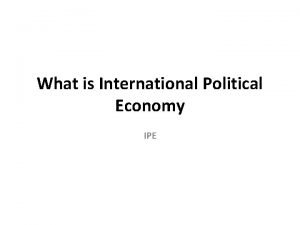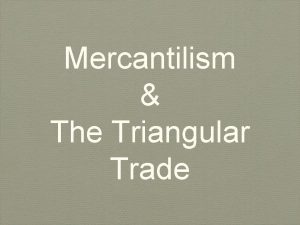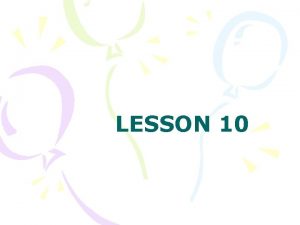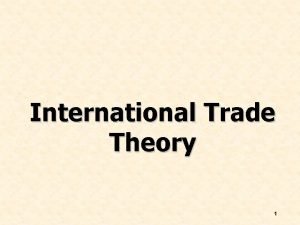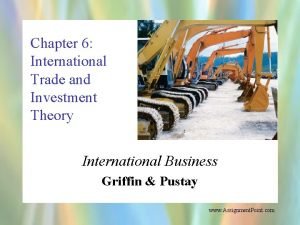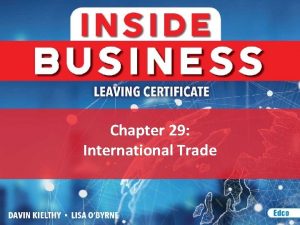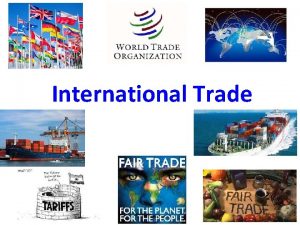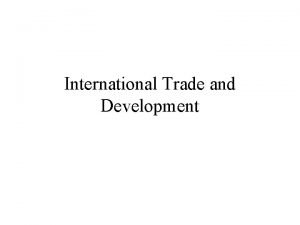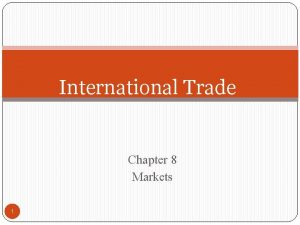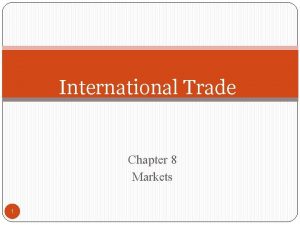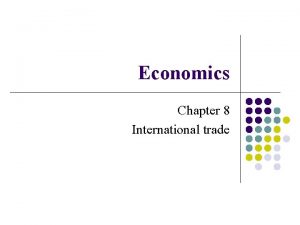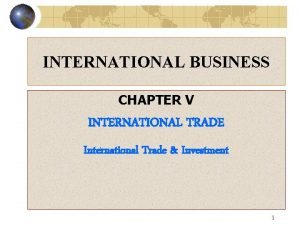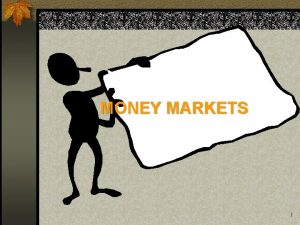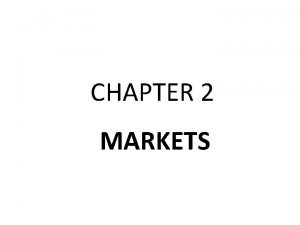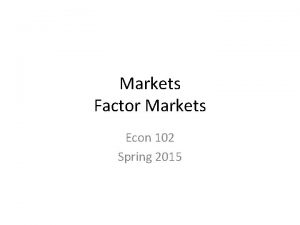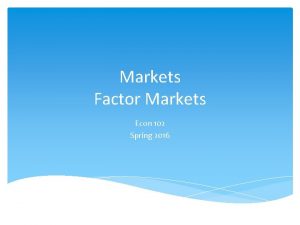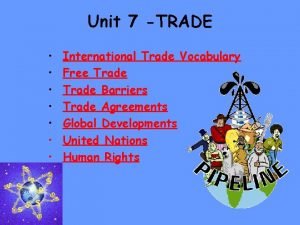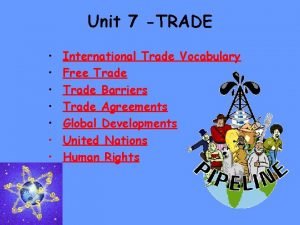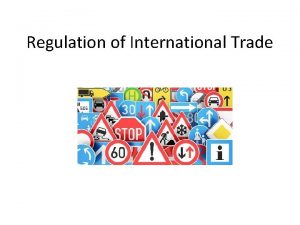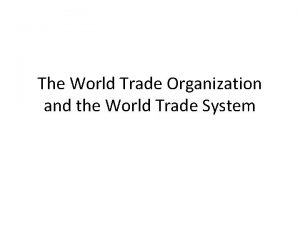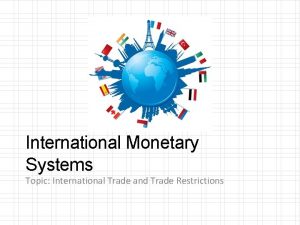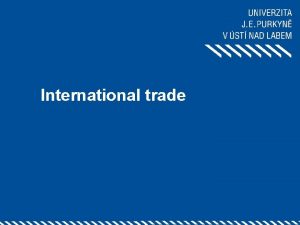TRADE AND DEVELOPMENT INTERNATIONAL TRADE AND WORLD MARKETS
































- Slides: 32

TRADE AND DEVELOPMENT

INTERNATIONAL TRADE AND WORLD MARKETS. ■ This is goods and services across country borders, where there is a benefit for both countries. ■ They each gain something which they cannot produce. ■ Without international trade each nation will only have access to their own resources. ■ Buyers and sellers trade on the international market.

1. COMMODITIES 2. TERMS OF TRADE

1. COMMODITIES ■ These are items which countries trade. ■ This could be raw materials. ■ Or finished products. ■ Only a small percentage was raw material in 2010 that was traded. ■ Most LEDC trade raw materials. Tis brings in way less money than finished products. ■ MEDC mainly exports finished products.

2. TERMS OF TRADE ■ This is the ratio between the value of exports and imports in a country. ■ Calculated b dividing the value of exports by the value of imports and multiplying by 100 ■ If equally balanced we term it will be 100 and it will be seen as unfavourable. ■ Earns more on the exports than the imports, we say it is favourable.

■ ACTIVITY 1 PAGE 211 – UNDERSTANDING TRADE ■ ACTIVITY 2 page 212 – CALCULATING AND COMPARING INTERNATIONLA TERMS OF TRADE.

TYPES OF TRADING RELATIONSHIPS 1. FREE TRADE 2. TRADE BARRIERS 1. Tariffs 2. Quotas 3. Subsidies 3. FAIR TRADE

1. FREE TRADE ■ Occurs without any restrictions. ■ Nations open their borders one another and goods and services move freely. ■ Countries with similar economic systems may form free trade.



2. TRADE BARRIERS ■ Free trade allowed cheap Chinese gods to be imported into the country ■ Putting strain on local business and causing some of them to close down. ■ Government regulates this by placing – Tarriffs – Quotas – Subsidies – On imported goods

Tariff ■ Are a type of tax placed on imported goods. Makes the goods more expensive. ■ Example tarrifs on cheap Chinese items could be 34% and 40% making it more expensive. ■ This is used as a source of income for the government.

QUOTAS ■ Are limits governments set to the amount of imported goods that can enter the country within a particular time frame. ■ When local production is lower than usual, quotas can be changed,

SUBSIDIES ■ Protects local business from foreign competition. ■ Are payments made by the government to local producers. ■ Government shares the production costs. ■ Therefore prices can be kept lower.

■ Subsidies are a trade barrier that works well for Japan, Europe and the USA> ■ Local prices in the country are lower than the imports. ■ Where farming is not subsidised. Imports can be cheaper. ■ Farmers may go out of business. ■ And the country will lose money.

■ Subsidies not only prevent fair competition, but negatively affect development in LEDC’s ■ E. g. cotton farmers in Africa lost up to $US 250 million per year because they could not sell their produce to the international market.

3. FAIR TRADE ■ The trading relationship is not between nations but between producers and consumers. ■ This gives farmers a fighting chance in developing countries.

■ Creating opportunities: producers directly linked to MEDC’s ■ Fair trade stable prices: producers involved in determining prices. Includes fair wage, production costs + environmental consideration. ■ Social development: re-invest extra income in community -building projects. ■ Gender equality: woman are paid the same as men ■ Sustainability: environmentally responsible methods are

GLOBALISATION



■ Process whereby the increased flow of goods, services, capital, technology, ideas, information ■ This then connects people.

ADVANTAGES ■ Multinational corporations (MNCs) – own or control production facilities in more than one country. ■ Increase employment opportunities. ■ Better working conditions. ■ Better salaries.

■ Increased access of information, ■ Spread of knowledge and innovations. ■ Rapid and effective natural disaster response and relief. ■ Increased tolerance and appreciation for cultural diversity. ■ Migrant workers send remittance of money they have earned back to their home countries. ■ Global associations distribute funds for development as well as regulate disputes. UN

■ Outsourcing: employing workers in another country. ■ Such as call centres/ tech support etc. ■ Global environmental awareness ■ Poverty is reduced, life expectancy increases and literacy rates increase ■ Relaxation of trade barriers promotes trade in development in developing countries.

DISADVANTAGES ■ Insufficient infrastructure to support technology – excludes some nations. ■ Employment inn MNC creates upper middle class – increase income inequalities. ■ MNC shows influence in their host countries. ■ Outsourcing creates unemployment. May lead to unfavourable working conditions. ■ Rules and Regulations of global associations influence governments. ■ Government spending might decline to pay off loans.

■ Brain drains might take place in LEDC ■ Economic dependency leads to global economic crises. ■ Technological advances may destroy traditional agricultural systems or erode cultures and languages. ■ Increase of trade and travel facilitates spread of human, animal and plant disease.

EXPORT LEAD DEVELOPMENT. ■ Economic strategy used by developing nations to catch up to developed ones. ■ Aim is to increase wealth by export. ■ Investing in industry, manufacturing and education in order to create export products. ■ Re-investing money earned in social and physical infrastructure. ■ ASIAN tigers are the most successful

Success of the Asian tigers related to ■ Their export products were seen as essential to technological revolution of the time. ■ Trade barriers were lowered. ■ Large consumer markets. USA

following this development countries have to follow. ■ Less favourable economic global economy ■ Industrialisation must take the environment into consideration. ■ Greater competition ■ Target markets may be saturated.

Newly Industrialised countries have the following characteristics ■ High level of social freedoms and civil rights. ■ Shift fro

■ Copy and summarise the mind maps on page 217 and 218
 The changing world output and world trade picture
The changing world output and world trade picture The changing world output and world trade picture
The changing world output and world trade picture International financial markets and instruments
International financial markets and instruments Types of exchange rate
Types of exchange rate Two businesses operate in contrasting international markets
Two businesses operate in contrasting international markets Pricing for international markets
Pricing for international markets Levich international financial markets
Levich international financial markets International financial markets levich
International financial markets levich Challenges of international business in emerging markets
Challenges of international business in emerging markets Strategies for competing in international markets
Strategies for competing in international markets Trade diversion and trade creation
Trade diversion and trade creation Umich
Umich Which is the most enduring free trade area in the world?
Which is the most enduring free trade area in the world? Trade diversion and trade creation
Trade diversion and trade creation Liner shipping and tramp shipping
Liner shipping and tramp shipping Unit 8
Unit 8 Chapter 6 - theories of international trade and investment
Chapter 6 - theories of international trade and investment Ifslearning
Ifslearning Kravis and linder theory of international trade
Kravis and linder theory of international trade Difference between balance of trade and balance of payment
Difference between balance of trade and balance of payment International trade and finance topics
International trade and finance topics Theories of international trade and investment
Theories of international trade and investment The trade in the trade-to-gdp ratio
The trade in the trade-to-gdp ratio Fair trade not free trade
Fair trade not free trade Triangular slave trade
Triangular slave trade Ipe is
Ipe is Mercantilism and triangular trade
Mercantilism and triangular trade Current theory of international trade adalah
Current theory of international trade adalah International trade theory
International trade theory International trade theory
International trade theory International trade theory
International trade theory Modern theory of trade
Modern theory of trade Importance of international trade
Importance of international trade
